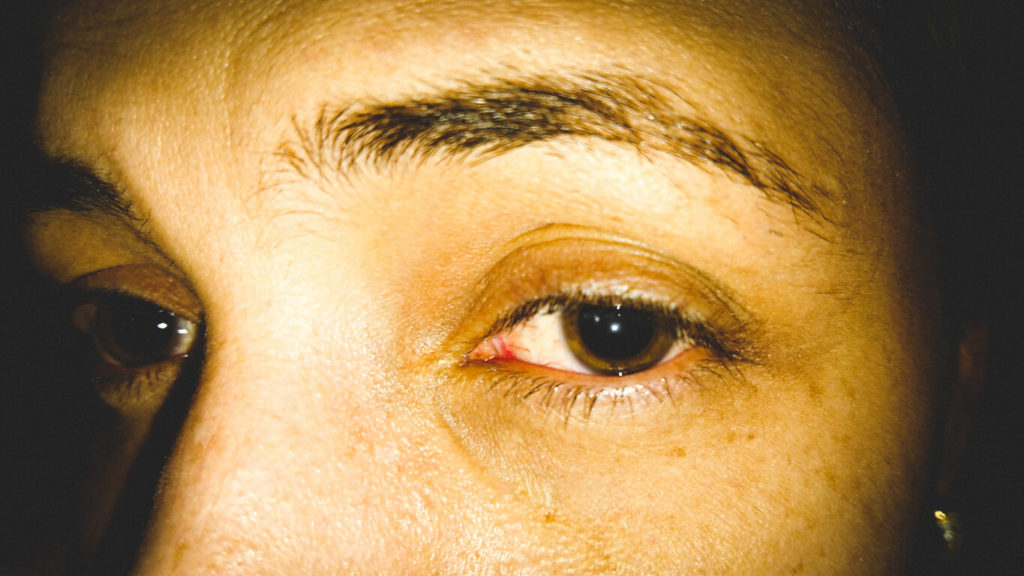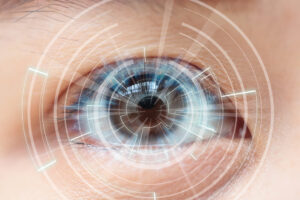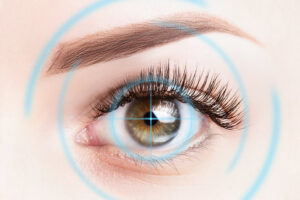
Most of the time, our eyes show a normal pupil size. Patients understand that pupil dilation (when pupils become larger) occurs in low light and will shrink in bright light.
Pupils will return to their normal size in time and without treatment. But, many patients are understandably concerned when their pupils, or those of a family member, suddenly enlarge and remain that way. Read on to learn about the causes of dilated pupils.
Why Do Pupils Dilate and Stay That Way?
There are many causes for dilated pupils that don’t return to their normal size. They include:
- Sexual attraction
- Eye diseases
- Eye or head injury
- Medication use
- Illicit drug use
- Hormonal imbalance (e.g. increase in the hormone oxytocin)
Get medical help immediately if you or someone you are with experiences sudden pupil dilation after an accident, or has dilated pupils accompanied by confusion. These might be signs of brain injury or stroke.
5 Causes of Dilated Pupils

-
Dilated Pupils Might Be a Sign of Sexual Attraction
Let’s start with a fun fact: pupil dilation that’s not caused by moving to dim lights can be a sign of attraction to someone nearby.
Oxytocin, the “love hormone” is one of the causes of dilated pupils. So, if you look into the eyes of your spouse or significant other during “alone time” and his or her eyes dilate, that means he or she finds you attractive. For most people, this is a heartening sign, right?
But like so much in medicine and life, it depends on the context.
Both hetero and gay men are susceptible to pupil enlargement when they see a man or woman they find attractive. If you’re out with your guy and notice his eyes are dilated when you return from the restroom, he’s probably noticed someone else. Before you break out into “lovehappy,” take a look to see if he’s eating or checking out the food whizzing by. The eyes in hungry people will dilate when they see something appetizing.
Women’s pupils often dilate when they see anyone they consider attractive, regardless of their own sexual orientation. So if your girlfriend’s pupils suddenly get bigger, don’t spin and look for Idris Elba or Kristen Stewart. You’ll have to trust her.
-
Mydriasis and Mydriasis-related Diseases
What is mydriasis? Also called benign episodic unilateral (or pupillary) mydriasis, it’s the diagnosis when one eye dilates. It’s considered (and labeled) benign because it usually isn’t linked to a severe problem. It will often come with blurry vision and a headache, and it’s been observed in younger women suffering from migraine.
The single eye dilation can last for hours or even days, but it will return to normal pupil size without treatment.
Not surprisingly, people with mydriasis are sensitive to light, particularly those who are migraine sufferers. We recommend wearing sunglasses when they are outdoors and get photochromic lenses that darken when exposed to bright light and sunlight if they wear glasses.
(Note: photochromic lenses do not darken inside cars with windows that have been even lightly tinted.)
People whose mydriasis is not caused by other eye diseases, medication, or injury may be prescribed a low dose of Pilocarpine, a prescription medication used to treat glaucoma to constrict the pupils.
Some other diseases are known causes for dilated pupils:
- Adie’s pupil is a neurological disorder where one pupil is larger than the other and is slow to react to light or lack of light. It sometimes occurs with surgery or trauma, infection, or poor blood circulation.
- Congenital aniridia occurs in people born without an iris or a partial one. It usually affects both eyes. Many patients have an incomplete optic nerve or retina as well as glaucoma or cataracts.
Both of these conditions are rare. There are no treatments for them, but treating the underlying causes such as infections and low blood pressure might lessen some of the symptoms of Adie’s.
- Stroke and brain tumors can also cause pupil dilatation. This is why doctors and first responders will immediately shine a light into the eyes of accident and trauma victims. Doctors also look at pupils during routine physical exams as well; an irregular-shaped pupil may indicate an aneurysm or neck tumor.
-
Medications and Illicit Drug Use Can Lead to Pupil Dilation
If you’re a parent, checking your youngsters’ eyes can be an excellent way to determine what they have been up to the past few hours. Amphetamines, ecstasy, cocaine, and LSD cause pupil dilation. On the other hand, so does a number of drugs taken for legitimate medical reasons, including:
- Antihistamines, which are often needed to relieve itchy eyes caused by allergens
- Decongestants
- Medications for motion sickness
- Anti-seizure medications
The neurotoxins in Botox can also cause pupil enlargement.
Most physicians won’t treat pupils that have dilated as a reaction to prescribed medication but instead allow the medication to wear off and prescribe a different drug.
-
Head and Eye Injury Can Cause Mydriasis
Eyes are delicate, and it’s not surprising to learn that they can be easily injured with long-lasting consequences including mydriasis. An injury that penetrates the eye can damage the nerves that control pupil dilation.
A head injury can affect the eyes. Pressure on the brain can easily affect the eye in many ways, including dilation. Damage to the third cranial nerve, which controls eye muscles, can result in mydriasis as well.
Physicians who are treating injury victims will closely monitor their eyes for signs of additional injury that may require surgery. Surgery can often repair eye damage. Follow-up care includes wearing eyepatches, medication, and eye drop treatment.
-
Lack of Norepinephrine Can Be Behind Some Dilated Pupils Causes
As we noted in the first fact above, oxytocin is just one hormone known to cause pupils to dilate. Research has suggested that pupil size changes with concentration. The hormone norepinephrine is thought to be behind pupil dilation in these instances.
A study of that tracked pupil sizes among children with attention deficit hyperactivity disorder (ADHD) reported in 2017 that their pupils enlarged when they were concentrating on memory-related tasks. The control group was children who didn’t take any ADHD medication for 24 hours before the research began.
- All children showed pupil enlargement during times of high concentration including their initial introduction to the exercise and later when concentrating to recall the steps.
- Children who took methylphenidate (Ritalin) performed better on tasks and maintained enlarged pupils. Ritalin regulates and speeds up brain activity powered by norepinephrine.
The researchers believe a drop in norepinephrine can lessen concentration, and that pupil enlargement is a sign of enhanced concentration. Changes in pupil size during periods of concentration may someday be a physical marker for ADHD. If you think need more information or medical guidance visit our Diamond Vision website.
Contact our Manhattan Eye Care Center if you are from New York.
Contact Us
If you have more questions about LASIK procedures, get in touch with us.
Related Blogs

Timing is Everything: When to Consider LASIK After Nursing for Optimal Results
Timing is everything when considering LASIK eye surgery after nursing, and understanding the optimal period for this procedure is vital for both mother and baby.

Cataract Surgery: Restoring Clarity and Confidence
Cataract surgery is a transformative procedure that offers a new lease on clear vision and renewed confidence. As cataracts cloud the eye’s lens, causing blurred

Intralase LASIK Explained: What to Expect Before, During, and After the Procedure
Intralase LASIK is a cutting-edge procedure that offers a safe, effective, and precise way to enhance vision compared to traditional LASIK methods. Understanding what to
